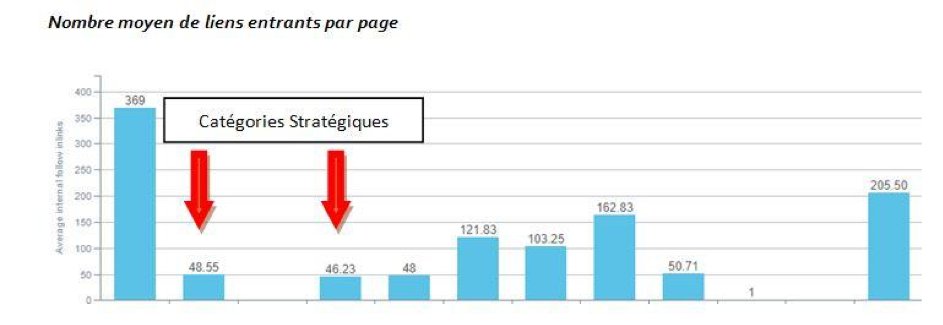Today, we won’t talk about backlinks, writing for the web, keywords research or even duplicate content. No: in this article, we will focus on internal linking.
Internal linking is essential for crawl optimization, discovering of new pages, and getting them ranked.
By the end of this article, you will understand that it is easy to rank for long tail keywords with an efficient internal linking strategy.
The strategy that we have used on our client’s website will give you a concrete illustration of the use of internal links for crawl optimization.
But before this, let’s have a quick reminder of what internal linking is.
Internal linking is the organization of relations (links) between pages. Its role is to:
- Establish how you navigate your website, its structure.
- Simplify your users’ navigation.
- Take users where you want them to go.
- Facilitate the discovery of pages by search engines.
We’ll also take this opportunity to quickly define what is referred to as crawl optimization:
Crawl optimization describes all the techniques used on a website to enable access by search engines bots (Google, Yahoo, Bing, Qwant, Yandex and many others…).
This exploration of your site from page to page allows the bot to store your URLs, to analyze them and to determine if they “deserve” to be indexed and thus to be presented to users for a given search.
If you want to know more about crawl optimization, you can read this article.
There are many ways to help the bot to better browse your site and optimize the time spent on your site during each crawl. For instance:
- The robots.txt file, the sitemap and the site plan,
- The elimination of internal redirects and duplicate content,
- A proper management of canonical tags and 404 errors,
- Internal linking, management of multi-faceted navigation and URLs with parameters,
- Fast response times.
[Ebook] How your internal linking scheme affects Inrank
Real-life case
We carried out improvements to optimize our client’s e-commerce website based on the implementation of an internal linking strategy.
KPIs before implementing internal linking
- 161 pages positioned for 559 potential URLs
- Ranking for 410 Top 100 keywords (including 6 keywords in Top 10)
- Research volume of 103 000 for the keywords ranked in the Top 100
Strategy deployed
Before the deployment of the internal linking strategy, we worked on the SEO optimization of the following points:
- Prioritisation,
- H1 and H2 tags
- WebPerformances (WPO).
Internal Linking Methodology
SEO audit findings concerning linking:
- Weakness of incoming links for strategic categories
- Presence of orphan pages.

Source: Oncrawl Screenshot
Number of incoming links par page

Source: Oncrawl Screenshot
Oprhan pages rate
3 separate applications of internal linking
1/ Reduction of the number of internal links
We have reduced the number of internal links which pointed to the same URL on the “listing” pages.
We find this mistake in many e-commerce websites where listing pages have 2 or 3 links pointing towards the product page:
- A link in the image,
- A link in the product name,
- A link in the buton “Learn more” or “Discover”.
When there are several identical links, Google will only take the first one it encounters into account. According to the page structure, the first link isn’t necessarily the one which is located on the product name but rather on the image. This creates a loss in semantic pertinence.
In addition to the “most important link” issue, we see a dilution of link juice caused by an abundance of links that are useless for your SEO.
Even if Google has signaled the end of the PageRank Toolbar, we retain (or we should retain) the notion of a loss of power between pages due to uncontrolled internal linking.
2/ Footers customization
With the client’s approval, we decided to delete all the links in the footer that were not useful for SEO. This means that the “legal notice” links and other similar pages are now only present on the homepage footer. We generated custom footers for the other page templates.
We could have used a “Grey Hat” method which consists of {hiding|disguising|covering} links from search engines (also called “link obfuscation”). This consists in transforming a link invisible to search engines into a clickable link for users during their navigation on the website.
This technique has been used for many years but does not have a good reputation because your could be penalised for “manipulating search engines”.
However, this method pays off when it is used intelligently. The proof is that many e-commerce websites have been using it for ages.
In their case, we could treat link obfuscation as a means to reconcile SEO and UX (for example: mega-menus are very popular with users but they can be a disaster for a thematic approach).
3/ Inter-city / inter-neighborhood linking
The aim of this internal linking operation was to help Google find as many pages as possible.
The first two operations allowed us to regulate the number of internal links (whether useless links, or links appearing in double or triple).
The final operation helped us to put an emphasis on listing pages thanks to the addition of a link in the footer which helps facilitate the crawl and discovery of new pages.
According to the listing page in question, we either developed a link network of “nearby inter-cities”, or a link network of “nearby inter-neighborhoods/districts”.
Improvements obtained
An increase of the daily crawl by 62% in 3 months.
KPIs after internal linking optimization
- 454 positioned pages out of 559 potential URLs (161 before linking)
- Rankings for 1900 Top 100 keywords (454 before linking) including 20 Top 10 keywords (6 before linking).
- Research volume of 388 190 on keywords ranked in the Top 100 (103 000 before linking).
Gains in added value
We have discovered almost 300 pages over the course of several weeks after the internal linking was set up! Thanks to this discovery, we expanded the number of Top 100 keywords and gained almost 1500 keywords. We also initialized potential set of high-volume keywords to develop and we multiplied the research volume by 3.
This strategy has generated opportunities for Top 100 keywords and we were able to multiply the performance of the Top 20 by 3. Finally, we were able to reduce the rate of orphan pages by 20%, even if we didn’t succeed in eradicating them completely.
These improvements in internal linking were carried out between March and May 2018. Since then, the site has grown with new products and content and has also benefited from netlinking.


Hi, a very interesting case study. I particularly like when you talk about obfuscation because I have developed a plugin for WP that allows obfuscate any link (or something less controversial, make it a or simply add a nofollow). You can download it here: https://www.fedegomez.es/link-juice-optimizer-plugin-optimizar-crawl-budget/